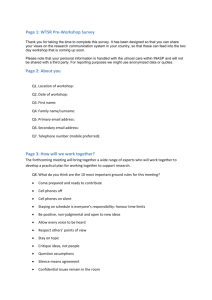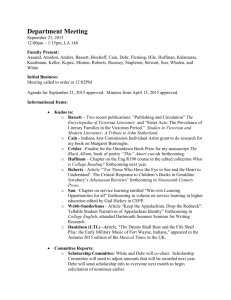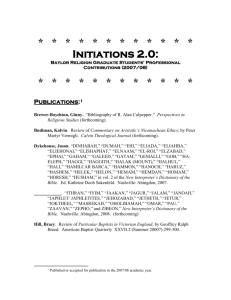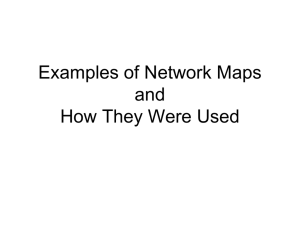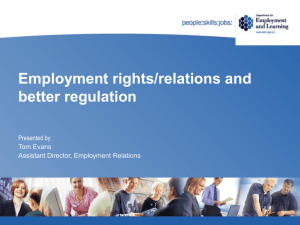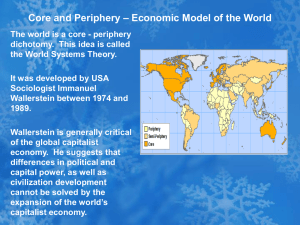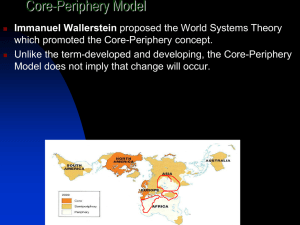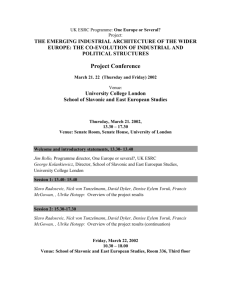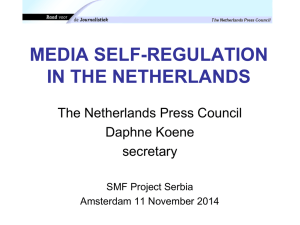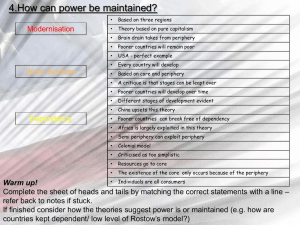Issues in management and organization of a flexible
advertisement
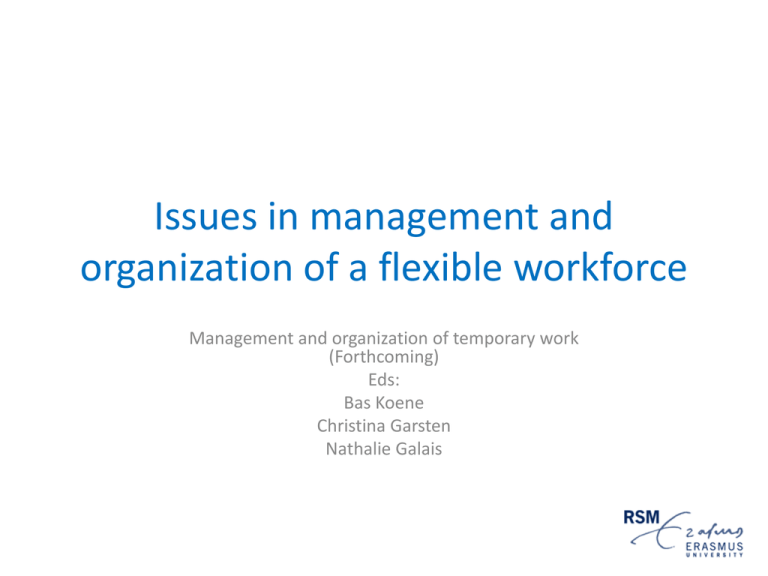
Issues in management and organization of a flexible workforce Management and organization of temporary work (Forthcoming) Eds: Bas Koene Christina Garsten Nathalie Galais Changed notions of flexibility • Specialization – Synergy temporary expert and organization (Matusik & Hill 1998; Nesheim et al.2007) • Rationalization Ad hoc – HR processes, labor sourcing strategies, breathing work force (Lepak& Snell, 1999) • Complexity – Local labor market imbalances, complex cross-border labor sourcing • Individualization – Itinerant professionals (Barley and Kunda, 2004) – Growth self-employed, shortening tenure 2 Structural Labour market challenges structural flexibilization • Responsibility for productive work-life and career organization individual • Labor market issues – flexicurity discussion – – – – Flexible and reliable contracts (integrate non-standard in labor law) Transition security Life-long learning Social security stimulate good mobility Organizational consequences? 3 What are challenges for organizations that might trigger them to contribute to sustainable organization of flexibility in the labor market? Challenges for organization structural flexibilization • Old routine: flexible, less managerial attention does not work anymore • Flexible staff becomes significant – Dutch companies: 20% 25% (Goudswaard et al.) – Organizations in dynamic market temp specialists in core (Nesheim et al.) – ‘Hollowing out of organizations’ (Anand and Daft, 2007) • Two important managerial issues: – Manage a blended work force – Flexible core requires stable/reliable periphery 5 Manage blended work force • Issues: – – • Research: – – – • How enhance equality and integration, while appreciating the differences? Dynamics of dual employment relationships (Chambel, forthcoming) Fair process in determining employment conditions. What process leads to balanced flexicurity solutions (Xhauflair and Pichault, forthcoming) Relates to issue of – 6 Not just compare flex attitudes to permanent staff Multiple relationships and attachment in triangular employment relation (towards client organization, core team, temporary work agency) How interaction regular and nonstandard staff affect identification, commitment, psychological contract Need to understand better: – – – • Careless management flex negative effect HR outcomes (Koene and van Riemsdijk,2005) Growing difficulties with growing share of temporary employees (Broschak and DavisBlake, 2006) Flexible and reliable contracts (integrate non-standard in labor law) Flexible core requires a stable periphery • Issues: – – • Research: – – – – • – – 7 Matusik and Hill say: easy, mutually beneficial dynamic between temp expert and organization However flexibilization often seen related to short-term cost reduction and rationalization (Koene and Riemsdijk; devalued treatment, Boyce et al 2007; employees experience low job quality, Olsen, 2006) 1950s organization man perspective dominates theory limited attention for managing the nonstandard periphery employees (Ashford et al. 2007) Key management challenges large share of highskill temps in core: e.g. Dependence (vulnerability, loss of competence); limited use voice (feedback and learning); dealing with integration vs separation of temps (limits to integration), social comparison and org justice considerations, (Nesheim et al., forthcoming) Need to understand better: – • Availability employees with right qualifications at the right time Tightening labor market, long-term development relevant skills How maintain relationship with outsider with unique experience (Lepak & Snell propose alliances?); Managerial skills and organizational competencies needed? (Anand and Daft suggest: mechanisms of collaboration, lateral relationships; seek clarity rather than control.) How to support and guide individuals with responsibility for their own productive work-life and career. HR practices for maintaining the external employment community when not connected. Relates to issues of – – – Transition security Lifelong learning Conditions for “Good mobility” Possible roles for temporary work agencies? Structural flexibilization • Simple opportunistic matching – • • – Precariousness of temping in little regulated markets Responsible and sophisticated matching – – – • – Regulated markets, importance stepping stone role, value in short-term matching and temp-to-perm Additional HR services (outsourced administrative HR services, On-site activities) Vendor Managed Services dealing with fragmentation/specialization of providers – – Structural cooperation with client organizations – • – Strategic cooperation agencies-client organizations – Employer responsibilities for those easy to place – • Niche markets for skilled labor profitable Taking responsibility for those who need support – – 8 Research Alternative temping in the US Public relevance, public pay: reintegration services in NL • Historical development in US (Smith and Neuwirth, 2008) and Netherlands reflect increasing sophistication (Koene and van Driel, 2011) Precariousness (Kalleberg,2009), temping self-reinforcing dual labour market (De Jong et al,2007), deregulation NL “dual temp market”? Evidence stepping stone function (e.g. deGraaf-Zijl et al, 2011) US Alternative Staffing example of active support disadvantaged workers (Carre et al, forthcoming) Strategic cooperation: Longer term HR performance improvements : efficiency, flexibility, labor market (Goudswaard and de Leede, forthcoming) Sweden temps permanent, temps higher skilled (Walter, forthcoming) Need to understand better: – – How do various models contribute to maintaining sustainable management and organization of flexible workforce? What conditions sustain the different models (institutional and resources)? New ways of organizing work? • Changed notions of flexibility – from adhoc structural – Responsibility productive work-life and career individualized • Labour market challenges and organizational challenges connected • • • • 9 Labour market Organizational challenges for client organizations Flexible and reliable contracts (integrate non-standard in labor law) Managing blended work force Transition security Lifelong learning Conditions for “Good mobility” Flexible core requires stable / reliable periphery Studies show increasingly sophisticated organization and management practices Solutions deviate more and more from the traditional model of employment Triangular employment solutions provide novel ways of dealing with challenges of flexibility Study concrete localized solutions for dealing with employment tensions fruitful
